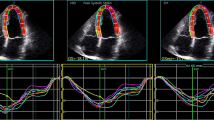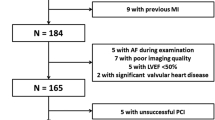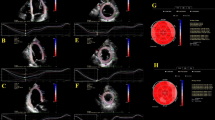Abstract
The aim of this study was to evaluate layer-specific global longitudinal strain (GLS), obtained by speckle tracking, in predicting outcomes following ST-segment elevation myocardial infarction (STEMI) treated with primary percutaneous coronary intervention (pPCI). Echocardiography, including layer-specific GLS, was performed at median two days after the STEMI in a prospective study of STEMI patients treated with pPCI between September 2006 and December 2008. The outcome was the composite of heart failure hospitalization and/or cardiovascular death (HF/CVD). A total of 349 patients were included. Mean age was 62.2 ± 11.5 years, 76% were male, and mean ejection fraction (LVEF) was 46 ± 9. Seventy-seven (22%) patients developed HF/CVD during median follow-up 5.4 years. Patients with HF/CVD had lower absolute values for all GLS-layers: endocardial (GLSEndo) 11.4%vs 14.5% (p < 0.001), midmyocardial (GLSMid) 9.8% vs 12.5% (p < 0.001) and epicardial (GLSEpi) 8.5% vs 10.9% (p < 0.001). In unadjusted analysis, all layers were significant predictors of HF/CVD; hazard ratio (HR) per 1% decrease for GLSEndo: HR 1.18 (95%CI 1.11–1.25), GLSMid: HR 1.22 (95%CI 1.14–1.30) and GLSEpi: HR 1.26 (95%CI 1.16–1.36), p < 0.0001 for all. The risk of HF/CVD increased incrementally with increasing tertiles for all layers, being more than three times higher in 3rd tertile compared to 1st tertile. In multivariable models, including baseline clinical and echocardiographic parameters, only GLSMid and GLSEpi remained independent predictors of HF/CVD. Global longitudinal strain obtained from all myocardial layers were significant predictors of incident HF and CVD following STEMI, however, only GLSMid and GLSEpi remained independent predictors after multivariable adjustment.


Similar content being viewed by others
References
Olsen FJ, Jensen J, Pedersen S et al (2016) A novel echocardiographic risk stratification scheme for predicting heart failure hospitalization and cardiovascular mortality after ST-segment elevation myocardial infarction. J Am Coll Cardiol 67(13):480. https://doi.org/10.1016/S0735-1097(16)30481-8
Mozaffarian D, Benjamin EJ, Go AS et al (2016) American Heart Association Statistics Committee, Stroke Statistics Subcommittee. Heart Disease and Stroke Statistics-2016 update: a report from the American Heart Association. Circulation 133:e38-360. https://doi.org/10.1161/CIR.0000000000000350
Bloch Thomsen PE, Jons C, Raatikainen MJP et al (2010) Cardiac Arrhythmias and Risk Stratification After Acute Myocardial Infarction (CARISMA) Study Group. Long-term recording of cardiac arrhythmias with an implantable cardiac monitor in patients with reduced ejection fraction after acute myocardial infarction: the Cardiac Arrhythmias and Risk Stratification After Acute Myocardial Infarction (CARISMA) study. Circulation 122:1258–1264. https://doi.org/10.1161/CIRCULATIONAHA.109.902148
O’Gara PT, Kushner FG, Ascheim DD et al (2012) 2013 ACCF/AHA guideline for the management of ST-elevation myocardial infarction: a report of the American College of Cardiology Foundation/American Heart Association Task Force on Practice Guidelines. J Am Coll Cardiol 61:e78-140. https://doi.org/10.1161/CIR.0b013e3182742cf6
Fox KF, Cowie MR, Wood DA et al (2001) Coronary artery disease as the cause of incident heart failure in the population. Eur Heart J 22:228–236. https://doi.org/10.1053/euhj.2000.2289
Lloyd-Jones DM, Larson MG, Leip EP et al (2002) Lifetime risk for developing congestive heart failure: the Framingham Heart Study. Circulation 106:3068–3072. https://doi.org/10.1161/01.cir.0000039105.49749.6f
Swedberg K, Cleland J, Dargie H et al (2005) Guidelines for the diagnosis and treatment of chronic heart failure: executive summary (update 2005): the task force for the diagnosis and treatment of chronic heart failure of the European Society of Cardiology. Eur Heart J 26:1115–1140. https://doi.org/10.1093/eurheartj/ehi204
Skaarup KG, Iversen A, Jørgensen PG et al (2018) Association between layer-specific global longitudinal strain and adverse outcomes following acute coronary syndrome. Eur Heart J Cardiovasc Imaging 19(12):1334–1342. https://doi.org/10.1093/ehjci/jey004
Ersbøll M, Valeur N, Mogensen UM et al (2013) Prediction of all-cause mortality and heart failure admissions from global left ventricular longitudinal strain in patients with acute myocardial infarction and preserved left ventricular ejection fraction. J Am Coll Cardiol 61(23):2365–2373. https://doi.org/10.1016/j.jacc.2013.02.061
Møller JE, Pellikka PA, Hillis GS et al (2006) Prognostic importance of diastolic function and filling pressure in patients with acute myocardial infarction. Circulation 114:438–444. https://doi.org/10.1161/CIRCULATIONAHA.105.601005
Park SJ, Park JH, Lee HS et al (2015) Impaired RV global longitudinal strain is associated with poor long-term clinical outcomes in patients with acute inferior STEMI. JACC Cardiovasc Imaging 8:161–169. https://doi.org/10.1016/j.jcmg.2014.10.011
Haeck MLA, Hoogslag GE, Boden H et al (2016) Prognostic implications of elevated pulmonary artery pressure after ST-segment elevation myocardial infarction. Am J Cardiol 118:326–331. https://doi.org/10.1016/j.amjcard.2016.05.008
Kümler T, Gislason GH, Køber L et al (2010) Persistence of the prognostic importance of left ventricular systolic function and heart failure after myocardial infarction: 17-year follow-up of the TRACE register. Eur J Heart Fail 12:805–811. https://doi.org/10.1093/eurjhf/hfq071
Spencer FA, Meyer TE, Gore JM et al (2002) Heterogeneity in the management and outcomes of patients with acute myocardial infarction complicated by heart failure: the National Registry of Myocardial Infarction. Circulation 105:2605–2610. https://doi.org/10.1161/01.cir.0000017861.00991.2f
Biering-Sørensen T, Solomon SD (2015) Assessing contractile function when ejection fraction is normal: a case for strain imaging. Circ Cardiovasc Imaging 8(11):e004181. https://doi.org/10.1161/CIRCIMAGING.115.004181
Blessberger H, Binder T (2010) Non-invasive imaging: two-dimensional speckle tracking echocardiography: basic principles. Heart Br Card Soc 96:716–722. https://doi.org/10.1136/hrt.2007.141002
Mor-Avi V, Lang RM, Badano LP et al (2011) Current and evolving echocardiographic techniques for the quantitative evaluation of cardiac mechanics: ASE/EAE consensus statement on methodology and indications endorsed by the Japanese Society of Echocardiography. J Am Soc Echocardiogr 24(3):277–313. https://doi.org/10.1016/j.echo.2011.01.015
Joyce E (2014) LVEF: long-standing monarch of systolic dysfunction, buckling under the strain? Eur J Heart Fail 16:1270–1272. https://doi.org/10.1002/ejhf.200
Kalam K, Otahal P, Marwick TH (2014) Prognostic implications of global LV dysfunction: a systematic review and meta-analysis of global longitudinal strain and ejection fraction. Heart Br Card Soc 100:1673–1680. https://doi.org/10.1136/heartjnl-2014-305538
Sengeløv M, Jørgensen PG, Jensen JS et al (2015) Global longitudinal strain is a superior predictor of all-cause mortality in heart failure with reduced ejection fraction. JACC Cardiovasc Imaging 8:1351–1359. https://doi.org/10.1016/j.jcmg.2015.07.013
Biering-Sørensen T, Knappe D, Pouleur AC et al (2017) Regional longitudinal deformation improves prediction of ventricular tachyarrhythmias in patients with heart failure with reduced ejection fraction: a MADIT-CRT substudy (Multicenter automatic defibrillator implantation trial-cardiac resynchronization therapy). Circ Cardiovasc Imaging 10(1):e005096. https://doi.org/10.1161/CIRCIMAGING.116.005096
Olsen FJ, Pedersen S, Jensen JS et al (2016) Global longitudinal strain predicts incident atrial fibrillation and stroke occurrence after acute myocardial infarction. Medicine (Baltimore) 95(44):e5338. https://doi.org/10.1097/MD.0000000000005338
Russo C, Jin Z, Elkind MSV et al (2014) Prevalence and prognostic value of subclinical left ventricular systolic dysfunction by global longitudinal strain in a community-based cohort. Eur J Heart Fail 16:1301–1309. https://doi.org/10.1002/ejhf.154
MacIver DH (2012) The relative impact of circumferential and longitudinal shortening on left ventricular ejection fraction and stroke volume. Exp Clin Cardiol 17(1):5–11
Adamu U, Schmitz F, Becker M et al (2009) Advanced speckle tracking echocardiography allowing a three-myocardial layer-specific analysis of deformation parameters. Eur J Echocardiogr 10(2):303–308. https://doi.org/10.1093/ejechocard/jen238
Kim SA, Park SM, Kim MN et al (2016) Assessment of left ventricular function by layer-specific strain and its relationship to structural remodelling in patients with hypertension. Can J Cardiol 32(2):211–216. https://doi.org/10.1016/j.cjca.2015.04.025
Sarvari SI, Haugaa KH, Zahid W et al (2013) Layer-specific quantification of myocardial deformation by strain echocardiography may reveal significant CAD in patients with non-ST-segment elevation acute coronary syndrome. JACC Cardiovasc Imaging 6(5):535–544. https://doi.org/10.1016/j.jcmg.2013.01.009
Zhang L, Wu WC, Ma H et al (2016) Usefulness of layer-specific strain for identifying complex CAD and predicting the severity of coronary lesions in patients with non-ST-segment elevation acute coronary syndrome: compared with syntax score. Int J Cardiol 223:1045–1052. https://doi.org/10.1016/j.ijcard.2016.08.277
Hagemann C, Hoffmann S, Andersen R et al (2017) Layer-specific strain analysis by two-dimensional speckle tracking echocardiography: improvement of coronary artery disease diagnostics in patients with stable Angina Pectoris. J Am Coll Cardiol 69:1634. https://doi.org/10.1016/S0735-1097(17)35023-4
Hagemann CE, Hoffmann S, Olsen FJ et al (2016) Layer-specific global longitudinal strain reveals impaired cardiac function in patients with reversible ischemia. J Am Coll Cardiol 67:1592. https://doi.org/10.1016/S0735-1097(16)31593-5
Biering-Sørensen T, Mogelvang R, Søgaard P et al (2013) Prognostic value of cardiac time intervals by tissue Doppler imaging M-mode in patients with acute ST-segment-elevation myocardial infarction treated with primary percutaneous coronary intervention. Circ Cardiovasc Imaging 6:457–465. https://doi.org/10.1161/CIRCIMAGING.112.000230
Biering-Sørensen T, Jensen JS, Pedersen SH et al (2016) Regional longitudinal myocardial deformation provides incremental prognostic information in patients with ST-segment elevation myocardial infarction. PLoS ONE 11(6):e0158280. https://doi.org/10.1371/journal.pone.0158280
Lang RM, Badano LP, Mor-Avi V et al (2015) Recommendations for cardiac chamber quantification by echocardiography in adults: an update from the American Society of Echocardiography and the European Association of Cardiovascular Imaging. Eur Heart J Cardiovasc Imaging 16:233–270. https://doi.org/10.1093/ehjci/jev014
Howard-Quijano K, McCabe M, Cheng A et al (2016) Left ventricular endocardial and epicardial strain changes with apical myocardial ischemia in an open-chest porcine model. Physiol Rep 4(24):e13042. https://doi.org/10.14814/phy2.13042
Leitman M, Lysiansky M, Lysyansky P et al (2010) Circumferential and longitudinal strain in 3 myocardial layers in normal subjects and in patients with regional left ventricular dysfunction. J Am Soc Echocardiogr 23(1):64–70. https://doi.org/10.1016/j.echo.2009.10.004
Tarr A, Stöbe S, Trache T et al (2013) The impact of fore-shortening on regional strain—a comparison of regional strain evaluation between speckle tracking and tissue velocity imaging. Ultraschall Med 34:446–453. https://doi.org/10.1055/s-0032-1330521
Shi J, Pan C, Kong D et al (2016) Left ventricular longitudinal and circumferential layer-specific myocardial strains and their determinants in healthy subjects. Echocardiography 33(4):510–518. https://doi.org/10.1111/echo.13132
Funding
None.
Author information
Authors and Affiliations
Contributions
All authors have contributed substantially to this paper.
Corresponding author
Ethics declarations
Conflict of interest
Peter Godsk Jørgensen has received lecture fees from Novo Nordisk.
Ethics approval
Anonymized data originated from a prospective study that was approved by a regional scientific ethics committee and complied with the declaration of Helsinki.
Additional information
Publisher's Note
Springer Nature remains neutral with regard to jurisdictional claims in published maps and institutional affiliations.
Rights and permissions
About this article
Cite this article
Grove, G.L., Pedersen, S., Olsen, F.J. et al. Layer-specific global longitudinal strain obtained by speckle tracking echocardiography for predicting heart failure and cardiovascular death following STEMI treated with primary PCI. Int J Cardiovasc Imaging 37, 2207–2215 (2021). https://doi.org/10.1007/s10554-021-02202-6
Received:
Accepted:
Published:
Issue Date:
DOI: https://doi.org/10.1007/s10554-021-02202-6




